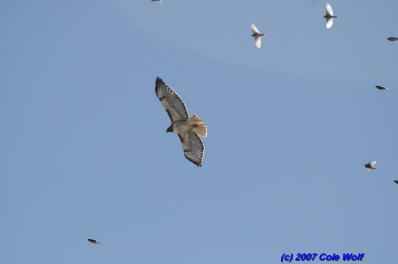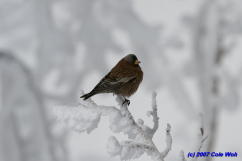
This past weekend, Cole Wolf, who assists in the banding of rosy-finches at Sandia Crest, New Mexico, observed and photographed a large flock of rosy-finches as they flew up and grouped around a Red-tailed Hawk. This hawk is more adept at catching rabbits, squirrels and rodents and is not a great threat to songbirds. However, it did encroach upon the finches’ feeding territory and triggered a deep instinct on their part to race towards it and surround it in the air, appearing to chase it away. Cole describes the encounter at this link, which includes several more photographs.
 While leading interpretive walks at Rio Grande Nature Center in Albuquerque I learned to always follow the crows. If the crows were in a frenzied flock and calling wildly, we would approach and take notice of the direction in which their bills were pointing. If the bills tended to converge on a certain spot, there we would almost surely find a large bird of prey. Usually it was a Great Horned Owl, but a couple of times it was a Red-tailed Hawk, and one winter, a Bald Eagle.
While leading interpretive walks at Rio Grande Nature Center in Albuquerque I learned to always follow the crows. If the crows were in a frenzied flock and calling wildly, we would approach and take notice of the direction in which their bills were pointing. If the bills tended to converge on a certain spot, there we would almost surely find a large bird of prey. Usually it was a Great Horned Owl, but a couple of times it was a Red-tailed Hawk, and one winter, a Bald Eagle.
One spring day, while walking a path along the meadow just below the Log at Capulin Spring in the Sandia Mountains east of Albuquerque, I spotted a Mountain Chickadee. The chickadee was just disappearing into a hole in at the end of a broken branch. I imitated the whistle of a Northern Pygmy-owl, a common predator at that location. Suddenly it seemed that not only the nesting chickadee, but every other neighboring chickadee, nuthatch, woodpecker, jay, robin, kinglet, vireo and warbler joined in excited calling. Nearly a dozen birds gathered just above my head, while many others called from deeper in the forest. A squirrel even started chattering!
I felt a bit guilty about the ruckus I had caused, for the birds needed every moment to devote to the care and feeding of their nestlings. Although I had stopped my owl whistle, for several minutes the birds congregated and the noise actually increased. They were not paying attention to me as much as to each other. An alarm had been triggered and there was clearly cross-species communication that something was threatening their safety. Then when they sensed it was “all clear,” they resumed their usual tasks.
We have noted that wild creatures tend not to waste energy—that their actions are usually purposeful, even if their meaning may not be immediately evident to us humans. “Mobbing,” the tendency of flocks of birds to approach certain predators is well known but the purpose of this behavior is open to speculation. Are the birds trying to drive the predator away? Are they simply alerting other birds to the danger?
Sometimes the attack is one-on-one, as kingbirds and Red-winged Blackbirds may attack crows and large hawks. I have seen small birds approach so closely to an owl that they seemed in real danger of being snapped up. One day I was amazed to see Merlin being mobbed aggressively by a mixed flock that included not only hefty Clark’s Nutcrackers and Steller’s Jays, but also tiny chickadees and bushtits. The Merlin could easily have taken off after even one of the larger birds and made a quick meal of it.
Studying the mobbing behavior of songbirds towards Eastern Screech-Owls, Gehlbach and Leveritt of Baylor University demonstrated that potential prey species perceived a greater threat from adult than immature owls, especially in their nesting and hunting territory. Older males and permanent residents of prey species participated in mobbing, while females, younger and visiting migrants tended to remain further away. The mobbing species were more responsive to the type of calls that the owls gave while hunting and in the spring, when they posed the greatest threat to nesting species. They expended their energies in direct proportion to the threat posed by the predator.












